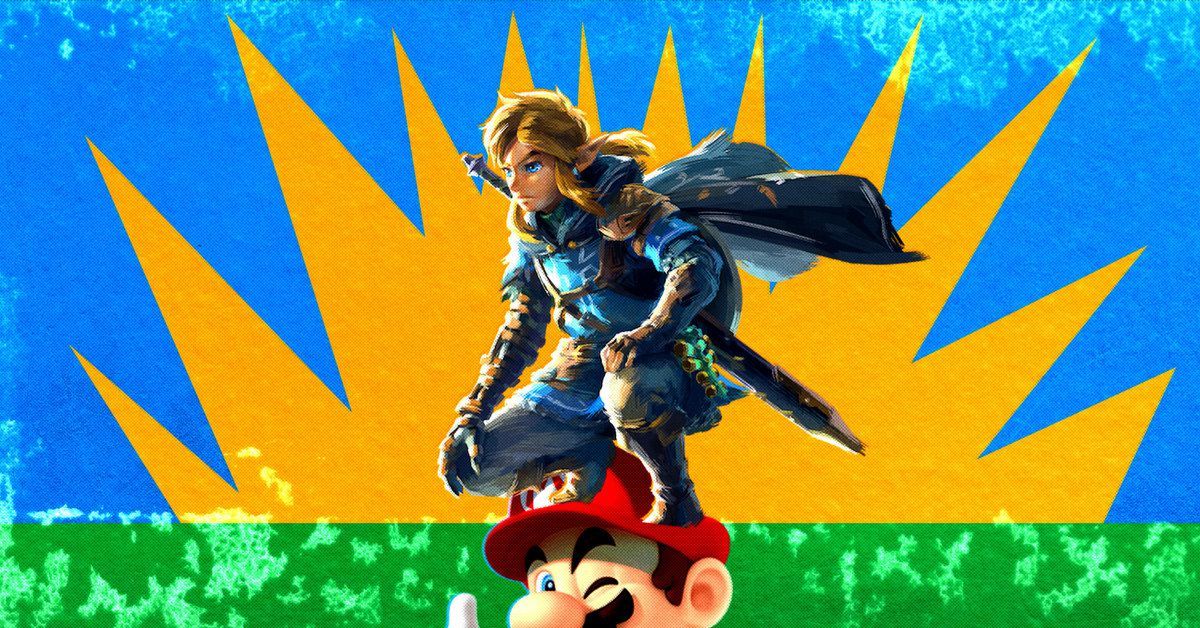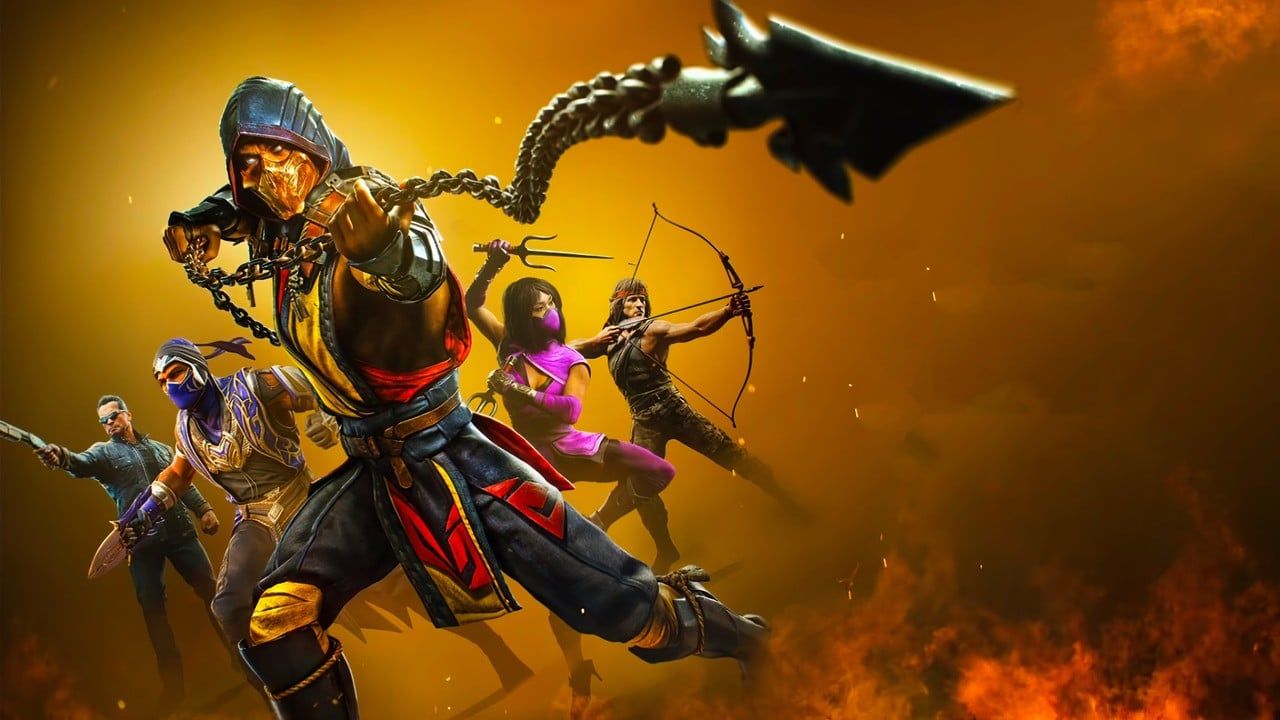‘Zelda,’ not ‘Mario,’ Is the Real Star of Nintendo
Last week, Nintendo released The Legend of Zelda: Tears of the Kingdom, the long-anticipated sequel to Breath of the Wild and indeed the most widely hyped video game of 2023. Tears of the Kingdom drops players back into the same overworld as Breath of the Wild but adds some uncharted territory and unique mechanics. The Kingdom of Hyrule now includes an aerial patchwork of forests, ruins, and shrines, called the Great Sky Island, as well as a subterranean network of treacherous caverns called the Depths. Link also learns a new suite of rune powers, chiefly Ultrahand, which allows him to fuse a variety of common objects into superstructures, such as bridges, and even vehicles. Link can build carriages, skiffs, hovercrafts, and even tanks and jets. This is the sort of emergent gameplay and redneck engineering that fans have come to love about Zelda on the Nintendo Switch.
Tears of the Kingdom follows a tough act. Breath of the Wild is, undoubtedly, the most influential video game of its generation. It was the first open-world game in the series, and while open-world titles were overabundant by the time the game launched with the Switch in 2017, Breath of the Wild remade the competitive landscape in its image. Link in Breath of the Wild was essentially a mountaineer. He could climb the highest peaks and paraglide great distances across breathtaking vistas. He could also use his special powers to further dominate the game’s vast territory. Link could climb a waterfall or cross a lake by summoning a series of glaciers as steps. He could momentarily suspend an object in place, whack it several times with any number of weapons, and then watch its accumulated momentum send it flying halfway across Hyrule. These elements effectively turned Hyrule into a massive sandbox. You could more or less ignore the game’s minimal plot of go to the four corners of the kingdom and retrieve yada yada so you can vanquish yada yada for hours at a time and instead take off in any direction and have fun conquering the terrain. Breath of the Wild reinvigorated Zelda. It reinvented open-world games. It became the generational standard for big-budget, console-selling, single-player action-adventure games.
It has also put Nintendo in a rather interesting position these days, as Zelda has arguably eclipsed Mario as the standard-bearer for the company and the Switch. This isn’t for any lack of trying or lack of success on Mario’s part. The latest mainline game in the series, Super Mario Odyssey, is only a few million units behind Breath of the Wild in lifetime sales; both titles are more than 20 million units short of the lifetime sales for the console’s bestselling game, Mario Kart 8 Deluxe. But Odyssey and Breath of the Wild, as the two classic mascot launch-year titles for the Switch, are quite different in scale. Odyssey introduced Cappy—Mario’s hat come to life, essentially—and his signature capture mechanic: The player could toss Cappy to temporarily “possess” objects, collect items, hit enemies, and otherwise enhance Mario’s mobility. This was a clever mechanic in the tradition of signature gimmicks in previous Mario games, such as the power washer in Super Mario Sunshine and the gravity variants in Super Mario Galaxy. But its novelty was rather limited. Odyssey, despite its title, was a short-and-sweet game with a brief core story and weak incentives for collecting its 880 power moons (rather than the usual stars), an objective less engaging than the work of clearing the 120 shrines in Breath of the Wild. Odyssey wasn’t really built for the sort of 100-hour playtimes that players would commonly rack up in Breath of the Wild. The real longevity in Mario on the Switch is in the multiplayer spinoffs: Mario Kart, Mario Party, and Mario Strikers.
Depending on how you look at the franchise, Mario seems either delightfully simple or increasingly stunted. The Super Mario Bros. Movie recently broke a billion dollars in global box office revenue and made for a nice, whimsical spectacle for young kids and nostalgic adults alike, but story-wise, the movie struggled to develop the timeless premise of the games—Mario rescues Princess Peach from King Koopa—into a tale worthy of a feature-length film (and probably a sequel or two). Mario and the Mushroom Kingdom have always been inscrutably cartoonish; Link, Zelda, and Hyrule have always been a bit more conventionally dramatic, if still a bit muted compared to the flagship single-player adventure titles on other consoles. Zelda has grown into a best-in-class action-adventure franchise. The past few mainline Mario games have been decently fun puzzle platformers—nothing revolutionary. Mario appeals to younger kids and series loyalists, while Zelda seems increasingly determined to captivate all ages and credibly compete with the more “mature” franchises in its genre, such as Elden Ring (which was similarly expansive and emergent), Death Stranding (which was similarly big into cross-country hiking), and Horizon (a still-fledgling series seemingly cursed to keep sharing release dates with decisive game of the year contenders). That’s a rather impressive feat for Nintendo, which continues to compete with Sony and Microsoft while producing less powerful hardware and instead prioritizing the in-house development of unique gameplay concepts.
Originally, Nintendo had planned to introduce some of the new features in Tears of the Kingdom in a series of updates to Breath of the Wild. The team working on those features spun the development into a stand-alone sequel only because the ideas got too numerous and complex to implement as downloadable content (though Breath of the Wild did get a couple of modest expansions). The result is a game that really does feel boundless in its geography and creativity. Despite the massive success of this sequel, I can’t imagine Nintendo will reuse these assets for a third consecutive entry, especially as the Switch ages and struggles to run newer, bigger games such as Tears. We’ll likely play the next Zelda on a new console. In the meantime, Mario may level up its gameplay ambitions in the final service years of the Switch. There are also whispers of a new Donkey Kong, reviving the series after a hiatus of nearly a decade. There’s still time for the three classic mascots—a sort of triforce, let’s call them—to send this console out with a bang together. For now, the Switch belongs to Link.
Source: The Ringer


